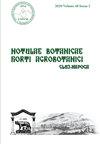GIS based soil erosion assessment using the USLE model for efficient land management: A case study in an area with diverse pedo-geomorphological and bioclimatic characteristics
IF 1.3
4区 生物学
Q3 PLANT SCIENCES
引用次数: 0
Abstract
The complex environmental process of soil erosion is crucial to sustainable land management and conservation. This study uses the Universal Soil Loss Equation (USLE) model to understand the intricate interactions that cause soil erosion in Cluj County, Romania, a region susceptible to complex erosion and landslide phenomenon. The established analysis depicts erosion patterns from localised hotspots to regions of relative stability, providing valuable insights into this critical issue. Spatial distribution maps with color-coded gradients show soil erosion risk and identify vulnerable regions, with temporal investigations depicting how environmental changes affect soil erosion, making it relevant to soil conservation and land management. A careful analysis of the USLE model's parameters (Ls, Cs, C, S, K) shows their soil erosion contributions. The erosion rates were graded in five classes in accordance to general practices of USLE modelling, which range from very-low, low, moderate, high and very-high susceptibility to soil erosion. While a significant majority of the county’s surface is represented by very-low and low erosion risk, several hotspots were identified with intense erosion processes that highlights the critical need to implement soil conservation measures in the area. Identifying erosion hotspots and conservation solutions encourages stakeholders to protect soils, and can provide policymakers with useful information for developing improved guidelines for soil and water conservation.基于GIS的土壤侵蚀评估,利用USLE模型进行有效的土地管理:以具有不同土壤地貌和生物气候特征的地区为例
土壤侵蚀的复杂环境过程对可持续土地管理和保护至关重要。本研究使用通用土壤流失方程(USLE)模型来了解导致罗马尼亚克卢日县土壤侵蚀的复杂相互作用,这是一个易受复杂侵蚀和滑坡现象影响的地区。已有的分析描述了从局部热点到相对稳定区域的侵蚀模式,为这一关键问题提供了有价值的见解。彩色梯度的空间分布图显示了土壤侵蚀风险并确定了脆弱区域,时间调查描绘了环境变化如何影响土壤侵蚀,使其与土壤保持和土地管理相关。仔细分析USLE模型的参数(Ls、Cs、C、S、K)可以看出它们对土壤侵蚀的贡献。根据USLE模型的一般做法,侵蚀率被分为五个等级,分别是对土壤侵蚀的极低、低、中等、高和非常高的易感性。虽然该县绝大多数地表为极低和低侵蚀风险地区,但确定了几个具有强烈侵蚀过程的热点地区,这凸显了在该地区实施土壤保持措施的迫切需要。确定侵蚀热点和水土保持解决方案可以鼓励利益相关者保护土壤,并可以为决策者提供有用的信息,以制定改进的水土保持指南。
本文章由计算机程序翻译,如有差异,请以英文原文为准。
求助全文
约1分钟内获得全文
求助全文
来源期刊

Notulae Botanicae Horti Agrobotanici Cluj-napoca
PLANT SCIENCES-
CiteScore
2.70
自引率
0.00%
发文量
118
审稿时长
3 months
期刊介绍:
Notulae Botanicae Horti Agrobotanici Cluj-Napoca is a peer-reviewed biannual journal aimed at disseminating significant research and original papers, critical reviews and short reviews. The subjects refer on plant biodiversity, genetics and plant breeding, development of new methodologies that can be of interest to a wide audience of plant scientists in all areas of plant biology, agriculture, horticulture and forestry. The journal encourages authors to frame their research questions and discuss their results in terms of the major questions of plant sciences, thereby maximizing the impact and value of their research, and thus in favor of spreading their studies outcome. The papers must be of potential interest to a significant number of scientists and, if specific to a local situation, must be relevant to a wide body of knowledge in life sciences. Articles should make a significant contribution to the advancement of knowledge or toward a better understanding of existing biological and agricultural concepts. An international Editorial Board advises the journal. The total content of the journal may be used for educational, non-profit purposes without regard to copyright. The distribution of the material is encouraged with the condition that the authors and the source (Notulae Botanicae Horti Agrobotanici Cluj-Napoca or JCR abbrev. title Not Bot Horti Agrobo) are mentioned.
 求助内容:
求助内容: 应助结果提醒方式:
应助结果提醒方式:


